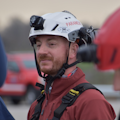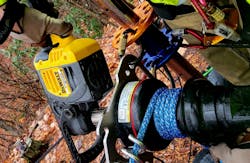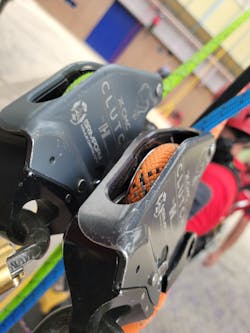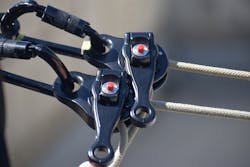Technical Rescue: Rope Rescue Gear—Balance Between Progression and Practicality
Long passed are the days of manila rope and wooden block and tackles. Now, we puff out our chest with high-efficiency, ball bearing pulleys and auto-locking carabiners. Much like cellphones, it seems as though as soon as you make a big purchase on the newest one, you already are behind the technology curve and ready for a replacement.
With the advent of innovation and rescue technology, where do we draw the line in rope rescue? When do we dig in our heels and stick to a cache setup that we can become proficient in? How do we maintain a mission-ready posture in a world of ever-changing gear?
Rope rescue innovations
In the past 20 years, it has been amazing to see the progression of rope rescue technology. For example, this year, CMC introduced its CAPTO, which is a multipurpose, integrated pulley/rope grab device. What a fantastic concept.
I love scrolling through social media and seeing all of the amazing products that are being developed that make rope rescue and rope access so much simpler. I remember my first figure 8 descender and nonlocking carabiners for rock climbing and rappelling when I first began to flirt with gravity-defying hobbies. I remember mastering the rack, pulley, mariner (RPM) system for raising and lowering in rescue systems. Now, we are shark-finning with two-tensioned rope systems (TTRS). It truly is a beautiful time to be alive.As a current practitioner of search and rescue and the owner of a rescue training company, I find myself in a difficult place at times. I always am trying to find the balance between showcasing the newest gear and techniques and implementing a practical application of how much I am willing to haul three miles into the woods with a team of three people to effect a rescue. The answer isn’t easy. One student came through one of our training courses recently and said, “All of this stuff is great, but our chief is never going to buy any of this.” Many students echo this exact sentiment. Looking through the lens of a chief or ranking administrative official, I believe that I would have to agree.
Training
If you want to embrace a culture of progression and change in the fire service, you must make an appraisal of what you and your organization are willing to commit.
As we are given more and more responsibilities in this all-hazard world in which we operate, the modern fire service is expected to be good at everything to which it responds. To maintain proficiency in hazmat, EMS, rescue, throwing ladders, fighting fire, customer service and everything else, we must train. In risk analysis, an organization might find that the need for additional rope skills is less likely than the need to incorporate a new medical device, particularly given that EMS calls are in excess of 80 percent of the run volume. With this logic, as progressive as a rescuer might be or as much as the individual would like to be that ambassador for change, additional rope skills training might not be in the cards for that person’s organization.I’ve been fortunate to train with some of the most disciplined and highly motivated groups in the armed forces. It’s impressive to see what a fine-tuned training program can produce while concurrently making a conscious decision to reside at the top of the chosen field.
We often say in the fire service “You can’t be good at everything” as we try to kill the motivation of that rescue tech who is participating in a sixth technician course for the year and is in hot pursuit of a becoming a rescue specialist. I must disagree with that premise. You can possess a high level of technical proficiency in a wide array of disciplines and subjects. However, you must commit to the training. If you give a Navy SEAL a lever-action Winchester 30-30 rifle, that person will do some damage with it. However, if you give that same Navy SEAL the weapon system that individual has trained with for the past two years, that person will change the course of the conflict.
The right tool with the right training is the recipe for success. You can’t have one without the other and expect expert results.
Equipment
The mission is everything. As a rescue technician, you must understand the scope of what must be done and then find the gear to execute that mission. The right gear increases the probability of success. Too much gear can be distracting and often is unnecessary.
In my world, we exclusively train and respond with ropes that are 11 mm or smaller. Further, we see search and rescue teams and the fire service slowly transitioning to smaller-diameter ropes and concomitant gear. Why? Is it because the concept is trendy? Is it “cool”? Did personnel go to a workshop or class and see it?
If your department makes three calls per year using ropes to effect a rescue, it might be quite difficult to justify spending thousands of taxpayer dollars to change out your current rope and gear cache just to save a few pounds. However, if your mission takes you deep into the woods or to great heights onto structures, every ounce of weight counts. When gear and personnel-limiting factors exist, then mission execution dictates a different gear loadout. You must adapt as an organization and as a rescuer to maximize the potential for success.
If you try to keep up with the newest and greatest rope rescue gadgets, your cache is going to get very big very quickly. It’s imperative that you find a balance. You want the right gear for the job, but you also know that the job changes. Twenty years ago, you might never have thought that responding to a tower crane operator who is having a medical emergency was in the cards for your department. Today, your downtown landscape might be littered with cranes. As target hazards change, so must we.
When you look to diversify or supplement your rope rescue equipment cache as a department, do your research. Try before you buy.
As a rescuer, don’t fall victim to the next coolest thing that you see. (There are myriad descenders out there.)
Don’t return from a cool rope workshop and tell the special operations chief that your department must buy something just because you saw it.
You must do your homework and take into account that changing any part of a defined rescue system is a process that has cascading effects on the department.Standards
Every single team, department and organization must adhere to standards. Having rules, regulations and guidelines enables all of us to operate in a common picture and to know the minimum performance that’s to be expected of us.
Often in training and response, I hear the misquotation of standards—most commonly, NFPA standards. If you are going to resist change based on a poor interpretation of a standard, then technical rescue might not be your wheelhouse. Standards are essential and necessary but should be adopted as what they are.
I always responded and trained under this credo: The two laws that you can’t violate are federal law and the laws of physics. One will get you jail time and/or fines; the other will get you killed. About anything else we can have an educated discussion.
When in the pursuit of allocating new gear and changing your rope rescue systems, ensure that you have adopted standards that are congruent with the work that you do (e.g., NFPA, American National Standards Institute, National Association of Tower Erectors, Occupational Safety and Health Administration, etc.). Gear should be tested to a standard that meets the risk and purpose of what your department or organization looks to do.
Our company has been fortunate to participate in several international rescue competitions over the past two years. It has been an eye-opening experience to see the application of a wide array of gear. Companies in Israel are developing and implementing quick-release devices using 8 mm rope for tactical and search and rescue operations. French companies are making products for rescue, arbor work, climbing and rope access. It’s important to resist the temptation to be in an echo chamber of your own ways. We innovate and improve through collaboration and asking questions. There is no room for a fragile ego in improving rope rescue systems and capability. Far too many people took a rope technician course 10 years ago and haven’t been on a rope since.
Continue to learn
The recipe for competency is training, equipment and experience. If you are unable to bring any of those to the table, outsource it. Social media can be a tool when used correctly. Use it to engage in forums, expand your rescue network and see what everyone else is doing. Asking questions about something that you don’t understand doesn’t demonstrate ignorance. Digging your heels in to resist change and progression because of a dogmatic approach to rescue does.
About the Author

Jeremy Urekew
Jeremy Urekew is a hazmat team manager for the FEMA Urban Search and Rescue Ohio Task Force 1, a wilderness rescue paramedic for Red Star Wilderness EMS, a rescue specialist with the KSP Hoist Rescue Team, and an active member of Powell County Search and Rescue. He was a firefighter and paramedic in Jefferson County, KY, where he served as a captain of a heavy rescue company. Urekew also serves as CBRNE subject matter expert at the Center for Domestic Preparedness in Anniston, AL.



